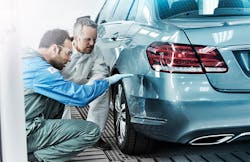Make The Right Certification Decision
Tim Ronak, senior service consultant, AkzoNobel, Vehicle Refinishes—North America, doesn’t mince words when it comes to the importance of following OEM repair procedures:
“The only way to repair a car. Period,” he says.
Amjad Farah, OEM key account manager for AkzoNobel, Vehicle Refinishes—North America, agrees.
“The OEMs are the makers of the vehicle and they should determine how it’s repaired,” Farah says. “We need to make sure that shops are in the best position to repair vehicles properly and part of that includes an approved paint line.”
AkzoNobel is currently approved for well over 50 of the top global OEMs, including GM, Ford, FCA, Porsche, Daimler, Toyota, Honda, Nissan, Hyundai, and Kia. On top of that, AkzoNobel was recently approved for Tesla, which makes Steve Morris, director of operations at Pride Collision Centers in California, very happy.
“When AkzoNobel got certified for Tesla, it was wonderful,” Morris says. “Now I can use one line of paint for all of my certifications.”
Pride Collision Centers has 12 OEM certifications and keeps adding to its list. When the opportunity to become a Tesla-certified shop fell into his lap, Morris literally hopped on a plane the next day to sign the papers. However, the decision to become certified can cost hundreds of thousands of dollars and it’s not always clear whether it’s worth the investment.
Importance of Certifications
Above all else, Ronak stresses the importance of performing repairs safely and up to the manufacturer's specifications.
“If a car is not repaired correctly, the shop that repaired that vehicle is 100 percent liable,” Ronak says.
Morris, an advocate of OEM certifications, says that OEMs have done a great job of providing the best way to perform vehicle repairs, which has eliminated any guesswork. He also thinks that in the age of technology, where consumers have access to all sorts of information, that it benefits the shop to have the ability to back up their promise of producing a quality repair.
With vehicles becoming more and more complex, the importance of OEM certifications will only grow. Ronak even thinks that it may become a requirement for certain insurers. Shops that do not make the investment will lose out on work and may eventually go out of business.
The Investment
Between the cost of approved equipment and training, OEM certifications can cost hundreds of thousands of dollars. When you’re looking at multiple certifications, that’s a significant investment that will require a lot of thought as to which certifications are right for your shop.
Making The Choice
Morris’ business partner, Randy Stabler, was at the SEMA Show when a representative from Tesla approached him to become a certified shop. Stabler called Morris and told him to get on a plane the next day to attend a Tesla-approved body shop conference in Las Vegas. For Morris, the decision was easy.
“We were able to make the decision quickly because we were already familiar working with aluminum intensive vehicles,” Morris says. “We already had a pretty good sense of what skill sets would be needed and we felt that training we had received from other OEMs laid a good baseline.”
Plus, Pride Collision Centers’ location in Southern California lends itself to Tesla repairs. Morris knew of two other Tesla-approved shops in the area and they were always busy. Being familiar with the process and the certifications that would be right for his shop made the choice easy for Morris, but for shop owners that are not familiar with it, pulling the trigger on a certification can be a daunting task.
Do Your Research
Looking at your shop’s demographics is essential before making the decision on which manufacturers to become certified in. As Morris mentioned, the California market is being penetrated by Teslas, but that certification may not make sense for everyone.
“If you’re in the middle of Iowa, Porsche probably isn’t the right choice for you,” Ronak says. “However, it may be a great fit for a shop in Orange County, California.”
Research the vehicles that come into your shop often. Those are the certifications that you should be looking at.
After you’ve made the decision which certifications to go after, Ronak stresses the importance of looking at the costs versus the potential return on investment. This goes back to analyzing the work that comes in. If you know you’ll see this type of vehicle at your shop enough to pay for the certification in a few years, then it’s worth it. If not, it may be worth rethinking.
When considering the investment, shops should also look at the equipment that they already have versus the equipment that they’ll need and how often it will need to be replaced, Ronak says. For example, if a shop has most of the approved equipment for a certain manufacturer, the investment won’t be as steep.
